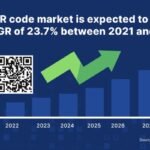In today’s competitive job market, standing out from the crowd requires creativity and strategic thinking. One innovative approach that’s gaining traction among job seekers is incorporating QR codes into resumes. These small, square barcodes can bridge the gap between your physical resume and digital portfolio, offering recruiters instant access to additional information about your qualifications.
What Are QR Codes and How Do They Work?
%20(1)%20(1).webp)
QR codes (Quick Response codes) are two-dimensional barcodes that can store various types of information, from simple text to website URLs. When scanned with a smartphone camera or QR code reader app, they instantly direct users to the encoded content. For job seekers, this technology presents a unique opportunity to extend their resume beyond the traditional one or two-page format.
Why You Should Consider Adding QR Codes to Your Resume
Enhanced Digital Presence QR codes allow you to seamlessly connect your physical resume to your online professional presence. Instead of listing long URLs that recruiters might not type in, a simple scan can direct them to your LinkedIn profile, personal website, or digital portfolio.
Demonstration of Tech-Savviness Including QR codes shows that you’re comfortable with current technology trends and willing to embrace innovative solutions. This can be particularly valuable for roles in tech, marketing, design, or any field where digital literacy is important.
Space Optimization Traditional resumes have limited space, forcing you to condense your achievements and experiences. QR codes provide a gateway to additional content without cluttering your resume layout.
Trackable Engagement When you create QR codes that link to your personal website or portfolio, you can track how many people scan them, giving you insights into recruiter engagement with your application.
Multimedia Showcase Unlike traditional resumes, QR codes can link to video introductions, audio samples of your work, interactive portfolios, or detailed project case studies that demonstrate your skills more comprehensively.
Strategic Ways to Use QR Codes on Your Resume
Link to Your Professional Website or Portfolio Create a QR code that directs to a well-designed personal website showcasing your work samples, detailed project descriptions, and professional achievements. This is particularly effective for creative professionals, developers, and consultants.
Connect to Your LinkedIn Profile Instead of including a long LinkedIn URL, use a QR code that takes recruiters directly to your optimized LinkedIn profile. Ensure your profile is current and professional before implementing this strategy.
Showcase Video Content Link to a brief professional introduction video, a demo reel of your work, or recorded presentations. This adds a personal touch and allows recruiters to see your communication skills and personality.
Provide Additional References or Recommendations Create a dedicated page with expanded references, testimonials, or detailed recommendation letters that couldn’t fit on your traditional resume.
Share Relevant Work Samples For professionals in fields like writing, design, or programming, QR codes can link directly to an online portfolio showcasing your best work examples.
Best Practices for QR Code Implementation
Strategic Placement Position your QR code in a location that doesn’t interfere with the resume’s flow. Common effective placements include the header area near your contact information, in a dedicated sidebar, or at the bottom of the page.
Include Clear Instructions Add a brief instruction like “Scan for portfolio” or “QR code to LinkedIn profile” so recruiters understand what they’ll find when they scan it. Never assume everyone knows how to use QR codes.
Test Thoroughly Before submitting your resume, test the QR code with multiple devices to ensure it works consistently. Check that it directs to the correct destination and that the linked content displays properly on mobile devices.
Maintain Professional Content Ensure that any content linked through QR codes maintains the same professional standard as your resume. The linked material should enhance your candidacy, not detract from it.
Keep It Simple Limit yourself to one or two QR codes maximum. Too many can make your resume look cluttered and gimmicky rather than professional and innovative.
Ensure Mobile Optimization Since QR codes are typically scanned with mobile devices, make sure any linked content is mobile-friendly and loads quickly on smartphones and tablets.
Technical Considerations
Choose Reliable QR Code Generators Use reputable QR code generators that provide high-quality, scannable codes. Popular options include QR Code Generator, QRStuff, or Google’s QR code generator.
Opt for Static vs. Dynamic Codes Static QR codes permanently link to a specific URL and don’t require ongoing maintenance. Dynamic codes allow you to change the destination URL without reprinting your resume, but may require a paid service.
Size and Quality Matters Ensure your QR code is large enough to scan easily (typically at least 1 inch square) and maintains high resolution when printed. A pixelated or too-small QR code won’t scan properly.
Consider Backup Plans Always include traditional contact methods alongside QR codes. Some recruiters may not be comfortable with or able to scan QR codes, so provide alternative ways to access your information.
Industry-Specific Applications
Creative Fields Designers, photographers, and artists can link to visual portfolios, client testimonials, or behind-the-scenes content that demonstrates their creative process.
Technology Sector Developers and IT professionals might link to GitHub repositories, live project demos, or technical blog posts that showcase their coding abilities and problem-solving skills.
Sales and Marketing These professionals can link to campaign results, client success stories, or metrics dashboards that quantify their achievements in ways that numbers on a resume cannot fully capture.
Education and Training Teachers and trainers might link to lesson plan examples, student feedback, or educational content they’ve developed to demonstrate their teaching methodology and effectiveness.
Potential Drawbacks to Consider
Technical Barriers Not all recruiters may be comfortable scanning QR codes, particularly in more traditional industries or among less tech-savvy hiring managers.
Applicant Tracking System Compatibility Many companies use ATS software to scan and parse resumes. QR codes might not translate well through these systems, potentially causing formatting issues.
Printing Limitations If your resume is printed in black and white or at low quality, QR codes might not scan properly. Always test printed versions before important submissions.
Privacy Concerns Some individuals may be hesitant to scan unknown QR codes due to security concerns, limiting the effectiveness of this strategy.
Making the Decision: Is a QR Code Right for Your Resume?
Consider your target industry, role level, and the companies you’re applying to. QR codes work particularly well for creative positions, tech roles, startups, and companies that value innovation. They may be less appropriate for highly traditional industries like law or finance, unless you’re applying for specifically tech-focused roles within those sectors.
The key is understanding your audience and ensuring that the QR code adds genuine value rather than appearing as a gimmick. When implemented thoughtfully, QR codes can set your resume apart and provide recruiters with a richer understanding of your qualifications and personality.
QR codes represent just one tool in the modern job seeker’s arsenal. When used strategically and professionally, they can enhance your application and demonstrate your willingness to embrace innovative approaches to professional communication. However, they should complement, not replace, a well-crafted traditional resume that clearly communicates your value proposition to potential employers.


